Q&A with What’s New In Publishing: Dianomi, the native ad marketplace for professional services brands and B2B publishers
Last modified on July 16th, 2020
Based in London, New York and Sydney, Dianomi is the native ad platform for the financial services, tech and corporate sectors, providing advertisers with access to a global audience of 200 million consumers. Despite volatility in ad spend during the pandemic, one exception has been a steady growth in financial brands spending on native advertising in premium outlets. WNIP caught up with Rupert Hodson, Co-Founder & CEO, Dianomi, to find out more…
What business problem is your company addressing?
Dianomi works with trusted publishers to monetize content through premium sponsored posts. While native advertising has received its share of criticism, with some people referring to it as ‘clickbait’, we approach sponsored content differently. Our focus from day one has been helping premium brands deliver native advertisements that people want to see in publications people want to read, honing in on the right audience and context.
We bridge the gap between advertiser and publisher, integrating advertising content with premium publication context, which ensures that no ads are served that aren’t relevant to a publication or reader.
Through our tech, every element of the communications mix is holistically optimised – audiences, advertising content, advertisement position, publication type, publication quality, delivery timing and delivery device work together.
What is your core product addressing this problem?
We’ve always prioritized premium campaign experiences and the best way to deliver that we believe is through native advertising with trusted partners on professionally curated content. Our cost-per-click model operates with complete transparency, scalability and all within a brand-safe environment.
Our marketplace connects 600 blue-chip financial brands — Prudential, Morgan Stanley, Chase and others — to a global audience of financially engaged consumers via 300+ of the world’s best-known business and finance publishers. Media properties for whom we drive revenue include The Wall Street Journal, Reuters, Kiplinger and MSN.

In terms of contextual targeting, we’ve identified 12 contextual audiences relevant for our advertising partners that allow for page-level targeting on our publishers’ sites. This level of granularity ensures advertisers are reaching the right audience without the reliance on third-party data, and at scale.
Can you give some examples of publishers successfully using your solution?
Aside from the publishers mentioned earlier, our roster includes Business Insider, VOX, Recode, Bloomberg, Fortune, and other premium business and financial publications.

Pricing?
Dianomi works on a cost per click (CPC) model, or cost per view for video advertisements.
What are other people doing in the space and why?
Because our marketplace is niche, with premium advertisers and publishers, we guarantee brand safety as well as ensure the content is shared with readers in a contextually relevant environment.
While there are others in the native advertising and contextual spaces, none have the reach or access to premium business and financial content in our vertical.
How do you view the future?
Over the years, through programmatic advertising, the ad ecosystem has moved from a targeting landscape that relied and worked on contextual relevance to one where advertisers were chasing audiences over the web through the use of third-party cookies. This led to major brand safety issues and fraud.
With CCPA now fully enforced and prominent, plus Google’s move to remove third-party cookies and playing catch up with Apple’s focus on data privacy, we are seeing a return to the simplicity and relevance of ad targeting based on context and focused on premium professionally curated content. Marketing does not have to be uber complicated to succeed. Quite the opposite.
Thank you.



















